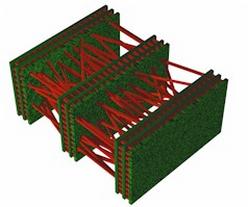Controlling Light with Light

Anyone who has worn polarized sun glasses knows that most light can be categorized as half horizontally polarized and half vertically polarized. Only one variety can pass through a sunglass lens, and the lens–which acts as a polarizer–can be rotated to change the polarization direction. Now a team of physicists reports a technique for changing the polarization direction of laser light using another laser beam. According to their scheme, published in the 19 October PRL, the controlling beam changes the properties of an atomic vapor through which both beams pass. Their method could be used to control polarization at wavelengths where it is currently not possible or as a way of switching light from one path to another in optical communications systems.
Shooting a laser beam of the correct wavelength through a cloud of atoms causes many of the photons to be absorbed as they boost atomic electrons from one energy level to another. But if the laser is tuned slightly away from that “resonant” wavelength, most of the photons can pass through the cloud, suffering only a phase shift–a change in the timing of their oscillating electric fields. Many recent experiments have demonstrated a way of controlling the phase shift using a second “control” laser tuned to a different wavelength. The control beam excites atoms in the gas so that their effects on the original, or “probe,” beam are altered.
Stephan Wielandy and Alexander Gaeta of Cornell University wanted to affect the two different polarization components of the probe beam in different but controllable ways, allowing them to prepare light in any combination of linear or circular polarization. To do this, they took advantage of “selection rules” that govern which atomic states in their rubidium gas will interact with a specific photon polarization. For example, an atom whose outermost electron is in a “p-orbital” state actually has three possible configurations, all of which have the same energy. But a photon from the polarized control beam can interact with only one of the three. With the probe beam polarized at a tilted angle with respect to the control, the probe has components both parallel and perpendicular to the control, but only the parallel-polarized photons feel the control’s effects. The other probe photons are unaffected by the control beam.
Using this basic trick, Wielandy and Gaeta were able to completely control the probe laser’s phase and thus rotate its polarization a full 90 degrees. At the same time, the probe suffered little absorption in the process. Other researchers using different techniques have managed to change the polarization by only a few degrees, and their experiments suffered from large amounts of absorption. The Cornell system allows one light beam to control the polarization of another, and therefore the ability of the second beam to transmit through a polarizer. Gaeta says that could lead to an improved optical switch–a system that quickly changes a beam’s direction–in optical communications. He says it could also lead to a system for polarization control in the deep ultraviolet or far infrared regions of the spectrum, where no method currently exists.
“It’s a clever idea,” says Julio Gea-Banacloche of the University of Arkansas in Fayetteville. He is impressed that the experiment seems simple, easily repeatable, and has possible applications. “I think this is going to have real significance,” agrees Stephen Harris of Stanford University. Over the past decade physicists have used light to control both absorption and refraction of light traveling through a gas, and Harris believes that adding polarization control will provide unprecedented ability to manipulate one light beam with another.


